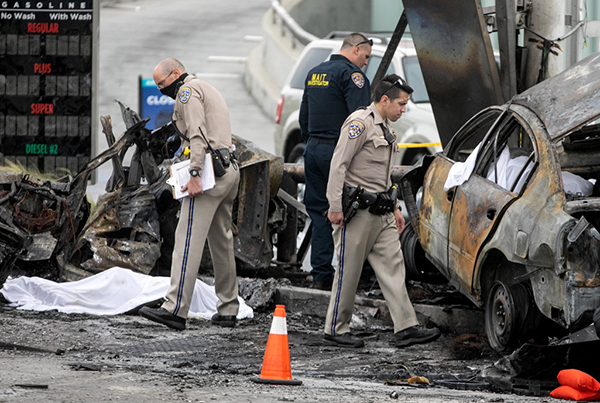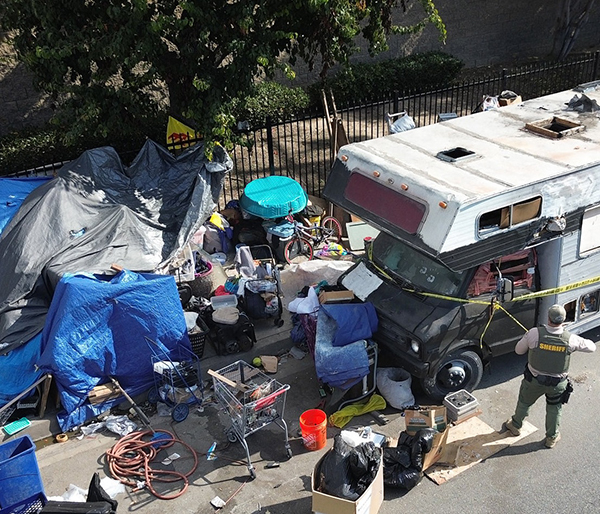By Earl Ofari Hutchinson
Contributing Columnist
“To ensure that underserved municipalities, neighborhoods and people, including low-income people and communities of color, are served equitably by the complete streets program.”
That was a major aim of the Complete Safe Streets Act introduced in the U.S. House of Representatives on Feb. 24, 2021, by Tennessee Democrat Steve Cohen. It was a big, broad sweeping measure that recognized one fact about America’s streets and highways, especially those in Black, Latino and Native American communities.
They were dangerous. And there was not a lot being done to make them safer.
More than a year after Cohen introduced his bill, I demanded that the Los Angeles County Board of Supervisors, the California Highway Patrol, the Los Angeles County Sheriff’s Department, and the county Department of Public Works do whatever it took to curtail the colossal pedestrian and vehicle hazards at the intersection of Slauson and La Brea avenues.
I and others knew and feared that this intersection, and many others throughout the city, posed a severe hazard precisely because of the unsafe conditions that prevailed on many urban streets that Cohen’s bill in large part aimed to address. The Aug. 4 crash was an accident waiting to happen. It finally did.
As we know, a 37-year-old registered nurse, Nicole Linton, crashed her vehicle in that intersection. The crash killed six persons, including a pregnant mother and her year-old child, and injured eight others.
However, what is less known is that seven months before the Aug. 4 crash, U.S. Secretary of Transportation Peter Buttigieg was plainly worried about the mounting danger of driving fatalities. What spurred Buttigieg was the near-record increase in car fatalities in 2020. Preliminary figures on traffic fatalities mid-year 2021, showed there was no indication that there would be a slowdown in the mounting toll by the close of 2021.
“It doesn’t look good, and I continue to be extremely concerned about the trend,” Buttigieg said at the time.
Unlike many other transportation experts and commentators, Buttigieg did not simply chalk up the mounting vehicle death toll to momentary aberrant behavior caused by the pandemic. He saw a more ominous picture emerging.
“Somehow it has become over the years and decades as normal, sort of the cost of doing business,” he said. “Even through a pandemic that led to considerably less driving, we continue to see more danger on our roads.”
He promised that his office and other highway transportation agencies would take action to curb the death toll. Buttigieg’s concern about the mounting death toll from traffic accidents and the Linton crash make it even more imperative to take action now.
What he didn’t say was that Blacks were by far the most at risk from vehicle fatalities. A study by the National Highway Traffic Safety Administration in June 2021 found that Black vehicle fatalities leaped a staggering 23% during the surge in 2020.
The grim numbers told the deadly tale that 38,680 people were killed in traffic crashes in 2020. Of those deaths, 7,494 were Black. That was by far the highest percentage increase of any race. The increase for white motorists was 4% from 2019.
Driving or walking for Blacks and many others was once again a recognized public hazard to health. There are clear reasons why.
The Safe Transportation Research and Education Center, a Berkeley-based, transportation safety advocacy group, made a graphic statement regarding the heightened peril that driving posed to Blacks, Latinos, and Native Americans.
“Over the past half century in the United States, medical advances, improvements in road and vehicle design and traffic safety efforts have all helped in reducing traffic-related injury and death,” the center’s statement said. “However, research suggests that among the U.S. population, certain ethnic groups, namely African Americans, American Indians and Latinos, continue to face higher traffic-related risk.
“Among all U.S. ethnic groups, motor-vehicle injury is a leading contributor to unnecessary injury and premature death. Improving traffic safety outcomes among these groups could help reduce their overall health disparities.”
The center’s worry and warning about the driving peril could not have been plainer. It entitled its report, “Traffic Safety in Communities of Color.”
The report was a wake-up call about the gross laxity or non-existence of viable traffic safety measures in those communities and hopefully a prod to state and local transportation officials to take affirmative action to reduce the greater hazard that vehicle deaths posed to these communities.
The problem was that the report was issued in 2003. It would be almost two decades before a comparable report was issued by a transportation safety advocacy group on the high hazard of traffic fatalities to Blacks and other minorities.
That study was by the Governors Highway Safety Association in June 2021. In its report, the association zeroed in on the inequality in traffic safety and called on states and communities to prioritize infrastructure investments in underserved communities and ensure diverse representation in transportation leadership.
The Slauson and La Brea crash and many others that claim so many lives reaffirms the truth that many of America’s streets and highways in Black and minority neighborhoods are health menaces. Now, as with any other health crisis, the question is what will be done about it?
Earl Ofari Hutchinson is an author and political analyst. He is the author of the forthcoming boob “Warning: Driving May Be Hazardous to Black Health” (Middle Passage Press). He also is the host of the weekly Hutchinson Report on KPFK 90.7 FM Los Angeles and the Pacifica Network.











